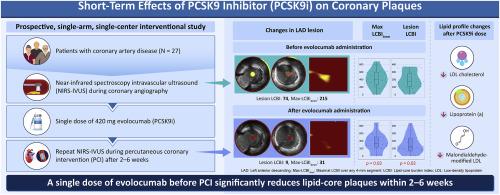Very short-term effects of a single dose of a proprotein convertase subtilisin/kexin 9 inhibitor before percutaneous coronary intervention: A single-arm study
IF 4.9
2区 医学
Q1 CARDIAC & CARDIOVASCULAR SYSTEMS
引用次数: 0
Abstract
Background and aims
The short-term (within 6 weeks) effects of proprotein convertase subtilisin/kexin 9 (PCSK9) inhibitors on lipid plaques have not been adequately evaluated. We aimed to investigate whether a single dose of a PCSK9 inhibitor before percutaneous coronary intervention (PCI) could reduce the abundance of lipid-core plaques identified via near-infrared spectroscopy intravascular ultrasound (NIRS-IVUS) at target lesions within a very short period.
Methods
This prospective, single-arm, single-center interventional study enrolled 27 consecutive patients with coronary artery disease. These patients underwent NIRS-IVUS during coronary angiography and repeat NIRS-IVUS during PCI performed between 2 and 6 weeks after the single-dose administration of 420 mg evolocumab. Changes in lesion lipid-core burden index (LCBI) and maximal LCBI over any 4-mm segment (max-LCBI4mm) were assessed using NIRS at the target lesions, along with lipid profile.
Results
The max-LCBI4mm significantly decreased from 387 before PCSK9 inhibitor administration to 315 after its administration (interquartile range [IQR]: 268–572 and 221–488, respectively; p = 0.02) within a very short period. The lesion LCBI also decreased from 161 to 117 (IQR: 105–263 and 65–226, respectively; p = 0.02). No significant changes were observed in the minimum lumen area and diameter. After PCSK9 inhibitor administration, low-density lipoprotein (LDL) cholesterol (p < 0.001), lipoprotein(a) (p = 0.001), and malondialdehyde-modified LDL (p < 0.001) levels decreased compared with those before its administration.
Conclusions
A single dose of the PCSK9 inhibitor administered before PCI reduced the abundance of lipid-core plaques identified via NIRS-IVUS at target lesions within a very short period of 2–6 weeks.

经皮冠状动脉介入治疗前单次服用蛋白转化酶枯草酶/kexin 9抑制剂的短期效果:单臂研究
目前尚未充分评估丙蛋白转化酶亚基酶/kexin 9(PCSK9)抑制剂对脂质斑块的短期(6周内)影响。我们的目的是研究在经皮冠状动脉介入治疗(PCI)前使用单剂量 PCSK9 抑制剂是否能在短期内减少通过近红外光谱血管内超声(NIRS-IVUS)在靶病变处发现的脂质核心斑块的数量。这项前瞻性、单臂、单中心介入研究连续招募了 27 名冠心病患者。这些患者在冠状动脉造影期间接受了 NIRS-IVUS 检查,并在单剂量服用 420 毫克 evolocumab 2 至 6 周后进行 PCI 时再次接受了 NIRS-IVUS 检查。在目标病变处使用 NIRS 评估了病变脂质核心负荷指数(LCBI)和任意 4 mm 区段最大 LCBI(max-LCBI)的变化,同时还评估了脂质概况。在很短的时间内,最大 LCBI 从 PCSK9 抑制剂用药前的 387 显著下降到用药后的 315(四分位数间距 [IQR]:分别为 268-572 和 221-488;= 0.02)。病变 LCBI 也从 161 降至 117(IQR 分别为 105-263 和 65-226;= 0.02)。最小管腔面积和直径没有明显变化。服用 PCSK9 抑制剂后,低密度脂蛋白胆固醇(< 0.001)、脂蛋白(a)(= 0.001)和丙二醛修饰的低密度脂蛋白(< 0.001)水平与服用前相比均有所下降。在PCI术前服用单剂量的PCSK9抑制剂可在2-6周的极短时间内减少通过NIRS-IVUS在目标病变处发现的脂质核心斑块的数量。
本文章由计算机程序翻译,如有差异,请以英文原文为准。
求助全文
约1分钟内获得全文
求助全文
来源期刊

Atherosclerosis
医学-外周血管病
CiteScore
9.80
自引率
3.80%
发文量
1269
审稿时长
36 days
期刊介绍:
Atherosclerosis has an open access mirror journal Atherosclerosis: X, sharing the same aims and scope, editorial team, submission system and rigorous peer review.
Atherosclerosis brings together, from all sources, papers concerned with investigation on atherosclerosis, its risk factors and clinical manifestations. Atherosclerosis covers basic and translational, clinical and population research approaches to arterial and vascular biology and disease, as well as their risk factors including: disturbances of lipid and lipoprotein metabolism, diabetes and hypertension, thrombosis, and inflammation. The Editors are interested in original or review papers dealing with the pathogenesis, environmental, genetic and epigenetic basis, diagnosis or treatment of atherosclerosis and related diseases as well as their risk factors.
 求助内容:
求助内容: 应助结果提醒方式:
应助结果提醒方式:


